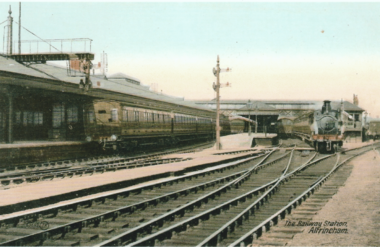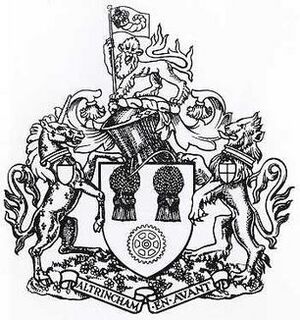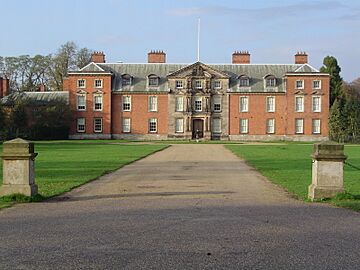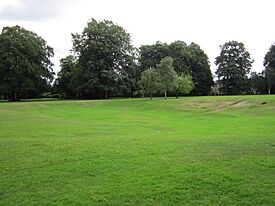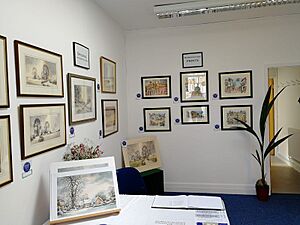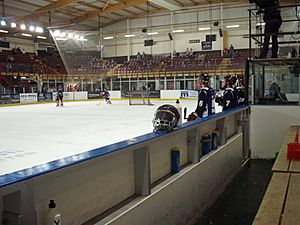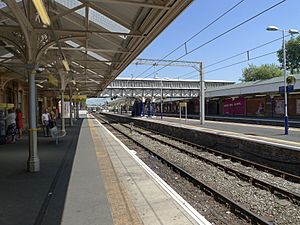Altrincham facts for kids
Quick facts for kids Altrincham |
|
|---|---|
|
Altrincham Town Centre |
|
| Population | 52,419 (2011) |
| • Density | 10,272/sq mi (3,966/km2) |
| OS grid reference | SJ765875 |
| • London | 161 mi (259 km) SE |
| Metropolitan borough | |
| Metropolitan county | |
| Region | |
| Country | England |
| Sovereign state | United Kingdom |
| Post town | ALTRINCHAM |
| Postcode district | WA14, WA15 |
| Dialling code | 0161 |
| Police | Greater Manchester |
| Fire | Greater Manchester |
| Ambulance | North West |
| EU Parliament | North West England |
| UK Parliament |
|
Altrincham (say OL-tring-əm) is a busy market town in Trafford, Greater Manchester, England. It is located south of the River Mersey. The town is about 8 miles (13 km) southwest of Manchester. It is also 3 miles (5 km) southwest of Sale. In 2011, Altrincham had a population of 52,419 people.
Altrincham has been a market town since 1290. This was a time when most towns focused on farming, not trade. Today, the town still has a market. The Bridgewater Canal reached Altrincham in 1765. Later, the railway arrived in 1849. These transport links helped the town grow and become more industrial. Over time, nearby villages became part of Altrincham. This included the land around Dunham Massey Hall. This historic hall is now a popular place to visit. It has three Grade I Listed Buildings and a deer park.
Altrincham has good transport connections. You can easily travel to Manchester, Sale, and other places. Many middle-class families live in Altrincham. The town is also home to Altrincham F.C., a football club. It also has three ice hockey clubs: Manchester Storm, Altrincham Aces, and Trafford Tornados.
Contents
History of Altrincham
You can find signs of early human life in Altrincham. Two Neolithic arrowheads have been found here. A Roman road also runs through the Broadheath area. This road connected important Roman forts. It was used for a long time, as it shows signs of being repaired. The name Altrincham likely means "homestead of Aldhere's people."
Before the Normans came to England, a Saxon lord named Alweard owned the land around Altrincham. After the Norman invasion, Hamon de Massey took ownership. Altrincham is not mentioned in the Domesday Book of 1086. The first official record of the town is from 1290. This is when Baron Hamon de Massey V gave it a special document called a charter. This charter made Altrincham a Free Borough. This meant it could hold a weekly market. De Massey probably created the town to earn money from taxes on trade. This makes Altrincham unusual for the Middle Ages. Most towns back then were mainly for farming. Altrincham was likely chosen for its good access to roads. This was important for trade.
The Altrincham Fair started in 1319. It was also called St James's Fair or Samjam. It continued until 1895. On fair days, there was a special court called the "Court of Pye Powder." This court settled arguments that happened during the day's trading. By 1348, Altrincham had 120 burgage plots. These were pieces of land owned by free men in the town. This made Altrincham as important as Macclesfield. It was even more important than Stockport and Knutsford. The oldest known house in Altrincham was "the Knoll." It was located near the town centre. Digs in 1983 showed it was built in the 13th or 14th century.
During the English Civil War, people from Altrincham fought for Parliament. Armies camped on nearby Bowdon Downs many times.
In 1754, a road south of Altrincham became a turnpike. These were toll roads where people paid to use them. This money helped maintain the roads. More sections were turnpiked later. By 1888, local councils took over road maintenance. The Bridgewater Canal reached Altrincham in 1765. This helped the town become known for growing vegetables. By 1767, warehouses were built along the canal in Broadheath. This was the start of Altrincham's industrial growth. The canal connected to the River Mersey in 1776. This gave the town a water route to Manchester and the Irish Sea.
In 1845, plans for a railway line to Altrincham were approved. The first train left Altrincham on July 20, 1849. It carried 65 passengers. The railway had two stations in town at first. Both were replaced in 1881 by Altrincham & Bowdon railway station. Other railway lines also connected Altrincham to nearby towns.
With the new railway links, Altrincham became a popular place to live. Many middle-class people and commuters moved here. They traveled to Manchester for work. Between 1851 and 1881, the population grew from 4,488 to 11,250. In 1885, the industrial area of Broadheath was created. It was designed to attract businesses. By 1900, Broadheath had its own docks and power station. Its location near rail, canal, and road links attracted companies. These companies made machine tools, cameras, and grinding machines. Broadheath became an important industrial area. By 1914, 14 companies operated there. They employed thousands of workers. One company, Linotype, even built 172 homes for its workers. This helped with the population boom. Between 1891 and 1901, Altrincham's population increased by 35 percent.
From the early 1900s to the start of Second World War, Altrincham changed little. The town saw some air raids during the war. However, it was not badly damaged. After the war, Altrincham experienced an economic boom. New houses were built, and the town centre was rebuilt in the 1960s. But in the 1970s, jobs in Broadheath decreased by almost 40 percent.
How Altrincham is Governed
Altrincham became a self-governing town in June 1290. This happened when Hamon de Massey V, the Lord of the Manor, granted its charter. The charter allowed a merchants' guild to be formed. This group of town leaders, called burgesses, could tax people passing through. The town was ruled by a Court Leet. This court elected a mayor since at least 1452. The court's jobs included keeping peace and managing markets.
Altrincham's local government changed over time. In 1851, a Local Board of Health was created. This board helped improve unhealthy conditions as the town grew. This was the first such board in the Trafford area.
In 1894, the local board became an urban district council. This council was part of Cheshire county. Altrincham Urban District grew in 1920. Parts of Carrington and Dunham Massey were added. Altrincham Town Hall was finished in 1901. More areas were added in 1936, including most of Timperley. In 1937, Altrincham became a municipal borough. It was given a coat of arms with symbols linked to its history.
In 1974, Altrincham became part of the Metropolitan Borough of Trafford. This happened when new local government laws were passed. Trafford Council now manages local services. These include education, social services, and waste collection. The Altrincham area is divided into seven voting areas called wards. These wards have 21 seats on the Trafford Council.
Altrincham is also part of the Altrincham and Sale West area for national government. Since 2024, Connor Rand from the Labour Party has been the Member of Parliament for this area.
Geography of Altrincham
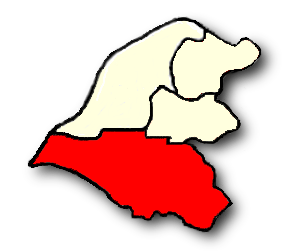
Altrincham is located at 53.3838°N, 2.3547°W. It is on the southwestern edge of the Greater Manchester Urban Area. It is just south of Sale. Altrincham is in the northwest corner of the Cheshire Plain. It lies just south of the River Mersey. The Bridgewater Canal flows through the Broadheath area of the town. Altrincham gets its drinking water from United Utilities. The rocks under the town are mostly sandstone. Water from these rocks is very hard.
The town's weather is generally mild. It does not have extreme temperatures or storms. The average temperature is a little higher than the UK average. Both annual rainfall and sunshine hours are a little lower than the UK average.
Altrincham is one of the four main urban areas in Trafford. The Altrincham area includes the town itself. It also includes the villages of Timperley, Bowdon, Hale, and Hale Barns. The Broadheath area used to be an industrial centre. Now, it is a retail park with many shops. The town centre is the most crowded part of Altrincham. Areas further from the centre, like Bowdon and Hale, have more green spaces. The Oldfield Brow area is on the edge of town. It is next to the Bridgewater Canal and near Dunham Massey.
People of Altrincham
| Ethnicity: Altrincham compared | |||
|---|---|---|---|
| 2011 UK Census | Altrincham | Trafford | England |
| Total population | 52,419 | 226,578 | 53,012,456 |
| White | 91.6% | 85.5% | 85.4% |
| Asian | 4.9% | 7.9% | 7.8% |
| Mixed | 2.0% | 2.7% | 2.3% |
| Black | 0.8% | 2.9% | 3.5% |
| Other | 0.7% | 1.0% | 1.0% |
In 2011, Altrincham had a population of 52,419 people. Of those aged 16 and over, 62.1 percent were couples living together. The town has 37.4 people per hectare. The population is 49.0% male and 51.0% female. About 15.2 percent of people aged 16 and over had no school qualifications. This is similar to the 18.6 percent in all of Trafford. Altrincham has a low number of non-white people, at 8.4 percent. Asians are the largest ethnic minority, making up 4.9 percent of the population.
In 1931, 14.6 percent of Altrincham's people were middle class. This was slightly higher than the average for England and Wales. By 1971, this gap grew. Altrincham had 28.8 percent middle class people, compared to 24 percent nationally. The number of working-class people in Altrincham decreased. This change in social structure made Altrincham the middle-class town it is today.
Population Changes Over Time
In 1664, Altrincham had about 636 people. This made it the largest local settlement. By 1801, the population grew to 1,692. In the first half of the 19th century, the town's population increased by 165 percent. This was due to the Industrial Revolution. Altrincham grew quickly, but not as fast as new industrial areas like Manchester. In the second half of the 19th century, Altrincham's population grew even faster. It increased by 275 percent. This was because of new industries and the railway.
| Population growth in Altrincham since 1801 | |||||||||||||||||||||||||||||||||||||||||||||||||||||||||||||||||||||||||||||||||
|---|---|---|---|---|---|---|---|---|---|---|---|---|---|---|---|---|---|---|---|---|---|---|---|---|---|---|---|---|---|---|---|---|---|---|---|---|---|---|---|---|---|---|---|---|---|---|---|---|---|---|---|---|---|---|---|---|---|---|---|---|---|---|---|---|---|---|---|---|---|---|---|---|---|---|---|---|---|---|---|---|---|
|
|
|
|
||||||||||||||||||||||||||||||||||||||||||||||||||||||||||||||||||||||||||||||
| Source: A Vision of Britain through Time | |||||||||||||||||||||||||||||||||||||||||||||||||||||||||||||||||||||||||||||||||
Economy of Altrincham
| Working age population: Altrincham compared | |||
|---|---|---|---|
| 2011 UK Census | Altrincham | Trafford | England |
| Population aged 16–74 | 37,743 | 162,806 | 38,881,374 |
| Full-time employment | 43.4% | 41.9% | 38.6% |
| Part-time employment | 13.9% | 14.0% | 13.7% |
| Self-employed | 11.5% | 9.7% | 9.8% |
| Unemployed | 3.1% | 3.8% | 4.4% |
| Retired | 13.5% | 13.3% | 13.7% |
Altrincham was historically a market town. Most jobs were in farming and market trade. The town faced a decline in the 15th century but recovered. The annual fairs continued until the mid-1800s. The market is still open today. During the Industrial Revolution, Altrincham grew as an industrial town. The Broadheath area became an industrial estate. In 1801, Altrincham had four cotton mills. However, they closed by 1851. The textile industry declined in Altrincham. This was due to a lack of investment. Other industrial areas like Manchester grew more.
In the late 1800s and early 1900s, heavier industries moved to Broadheath. This created many local jobs. But the area declined in the second half of the 20th century. Jobs in Broadheath fell from 8,000 to 5,000 between 1960 and 1970. Altrincham has big shops like Tesco and Marks & Spencer. A new Asda superstore is in Broadheath. Despite this, Altrincham's retail employment is below the national average. Altrincham, along with Bowdon and Hale, is known for its nice homes.
The historic market town became a residential area in the 1800s. But it still has its shopping history in the Old Market Place. A new shopping centre has also been built. However, the town's shops have faced challenges. Competition from the nearby Trafford Centre and a rebuilt Manchester city centre has affected them. In 2006, Trafford Council planned a £1.5 million redevelopment for the town centre. This plan aimed to create new and improved retail spaces.
Construction on Altair, a £100 million project, started in 2019. This project includes apartments, shops, and restaurants. It will also create a new public square. This square will connect to the Altrincham Interchange. The Interchange was refurbished in 2015. A 2010 survey found that many shops in Altrincham were empty. The council blamed this on the economic recession.
According to the 2011 UK census, the main jobs in Altrincham were in retail (14.8%). Other major industries included health and social work (13.0%). Professional and scientific activities made up 11.6%. The unemployment rate in Altrincham was 3.1 percent. This was low compared to the national rate of 4.4 percent.
Culture in Altrincham
Landmarks and Attractions
The Old Market Place is believed to be where the town first started. It is now a protected area. It has many old buildings with wooden frames. These buildings show how houses were built long ago. The cobblestone ground was replaced in 1896. The Buttermarket was also in this area. It was a place for early local justice. A courtroom, stocks, and whipping post were here. Public whippings happened until the early 1800s. The whipping post and stocks were restored for tourists in the 1990s. The Buttermarket was also important for religious reasons. Couples would declare their plans to marry there. In 1814, writer Thomas de Quincey described the Old Market Place. He noted how little it had changed. He saw fruits and flowers everywhere. He also mentioned the clean butcher stalls and "bonny young women of Altrincham." In 1974, local artist George Allen painted the Old Market Place. This painting was used on postcards to promote Altrincham.
Another popular attraction is the historic market. It was set up over 700 years ago when the town began.
Trafford has 21 protected conservation areas. Ten of these are in Altrincham. These include The Downs, The Devisdale, and the Old Market Place. On the edge of town is the 18th-century Dunham Massey Hall. It is surrounded by a 250-acre (1 km²) deer park. The National Trust now owns both. The hall is in an early Georgian style. It is a Grade I listed building, along with its stables.
Royd House was built between 1914 and 1916. It was designed by local architect Edgar Wood for himself. It has a flat concrete roof and a curved front. It is made of red stone and brick. It is considered a very modern example of early 20th-century homes. It has been a Grade I listed building since 1975. The Grade II listed clock outside the main transport hub was built in 1880.
The 16-acre (6.5 ha) Stamford Park was designed by John Shaw. It opened to the public in 1880. It was a sports park with areas for cricket and football. The land was given by George Grey, 7th Earl of Stamford. Trafford Council now owns and runs the park. It is listed as Grade II on the Register of Parks and Gardens.
John Leigh Park is in the Oldfield Brow area. Oldfield Hall used to be on this site. In 1917, Mr John Leigh bought the land. He gave it to the local council to be a park for soldiers and workers. The park was named 'John Leigh Park' and opened on July 22, 1917.
Events and Venues
Altrincham has its own annual festival. It has been held for over 40 years. The festival takes place in late June or early July. It is run by volunteers and is self-funded. The event includes a parade through the town. It ends with a two-day music and family event at Beechfields. This family event has a stage for local music. It also has a fun fair, food, and community stalls. It is the largest free family event in Trafford.
Altrincham has two theatres. These are the Altrincham Garrick Playhouse and the Club Theatre. The Altrincham Garrick group started in 1913. In 1982, the Garrick held the world premiere of the play Psycho. In 1998, it received a large grant for redevelopment. The Club Theatre group started in 1896. It hosts the Trafford Youth Theatre production each year. It also runs the Hale One Act Festival. This is an annual event that started in 1972.
Sport in Altrincham
Altrincham F.C., known as The Robins, was founded in 1903. They play home matches at Moss Lane. The club plays in the National League. In the 1970s and 1980s, Altrincham F.C. became famous for beating bigger teams. They knocked out Football League teams a record 16 times in the FA Cup. This included a win against top-flight Birmingham City in 1986. Altrincham won the Football Conference in its first two seasons. However, they were not allowed to join the Football League. They missed by just one vote in 1980. The club has had mixed results since then. They were promoted five times and relegated five times. They were most recently promoted to the National League in 2019-20. Their main rivals are Macclesfield Town and Northwich Victoria.
Altrincham has an ice rink. It has had an ice hockey team since 1961. The Altrincham Aces played from 1961 until 2003. Then, the Altrincham Ice Rink closed. The town had no rink or team for three years. Then, the Altrincham Ice Dome was built. It can hold 2,500 people. The Manchester Phoenix ice hockey team moved to the Ice Dome in 2006. In 2009, the Manchester Phoenix team in the English National Ice Hockey League was renamed Trafford Metros. This brought back the old Altrincham team's name. When not used by the Phoenix, the Ice Dome is open for public ice skating.
Altrincham Kersal RUFC was founded in 1897. They play rugby union. The club has produced famous players like Mark Cueto and Chris Jones.
Altrincham and District Athletics Club started in 1961. It offers training for track and field, road running, and cross-country running. Seamons Cycling Club was formed in 1948.
Media in Altrincham
Local news and TV shows come from BBC North West and ITV Granada. Radio stations include BBC Radio Manchester and Heart North West. There is also RadioAlty, a local community station. The town's local newspapers are Sale & Altrincham Messenger and Altrincham Today.
Education in Altrincham
In the past, children from Altrincham might have gone to a school in Bowdon. Before that, Altrincham had no formal schools. A salt merchant started a school at Oldfield House for 40 boys. Sunday schools also began in the late 1700s and early 1800s. As Altrincham's population grew, more schools were founded. By 1856, the town had 9 schools and 23 teachers. When education became required, more schools were needed. By 1886, Altrincham had 12 church schools and 8 private schools.
Cheshire County Council took over local education in 1903. Loreto Convent, the County High School for Girls, and Altrincham County High School for Boys were founded. These schools are still open today. They are now called Loreto Grammar School, Altrincham Grammar School for Girls, and Altrincham Grammar School for Boys. Altrincham also took in children during the Second World War. St. Ambrose College was founded during this time.
Altrincham now has eighteen primary schools. It also has one special school and eight secondary schools. Five of these are grammar schools. The Trafford area uses a selective education system. Students take entrance exams to get into these schools. Several secondary schools in Altrincham have special status. For example, Altrincham College is an arts college. Altrincham Grammar School for Boys and Girls specialize in languages. Blessed Thomas Holford Catholic College and St. Ambrose College focus on maths and computing. Loreto Grammar School specializes in science and maths. Many of these schools were rated as outstanding in 2011–12. Brentwood Special School is for students aged 11 to 19 with special needs.
Altrincham is home to Oakfield Nursery School. It is one of the oldest family-owned nursery schools in the UK. Oakfield was named 'UK Nursery of the Year' in 2014.
Religion in Altrincham
In the past, Altrincham was part of Bowdon parish. The town did not have its own church until 1799. This is when the Anglican church built a small chapel. Other Christian groups were also in Altrincham. Methodists built a chapel in 1790. Baptists built one in the 1870s. Irish immigrants in the 1830s and 1840s brought Roman Catholicism back to the area. The first Roman Catholic church in Altrincham was St Vincent's, built in 1860.
Several churches in Altrincham are important buildings. They are listed as Grade II buildings. These include Christ Church and St George's Church. Three churches in Altrincham are Grade II* listed buildings. These are the Church of St Margaret, the Church of St John the Divine, and Hale Chapel.
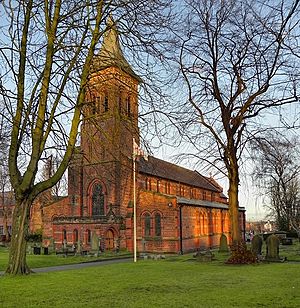
In the 2001 UK census, most Altrincham residents were Christian (78.8%). Other religions included Jewish (1.1%), Muslim (1.1%), and Hindu (0.4%). About 12.1 percent said they had no religion. Altrincham is part of the Roman Catholic Diocese of Shrewsbury. It is also in the Church of England Diocese of Chester. The closest synagogue is in Hale Barns.
Transport in Altrincham
Building the Manchester South Junction and Altrincham Railway started in 1845. The line opened in October 1849. It connected Manchester to Altrincham. In 1931, it became one of Britain's first electrified railway lines. A new Altrincham station also opened on the same line at Navigation Road. By 1937, 130 trains ran daily between Manchester and Altrincham. The line was updated in the early 1990s. It became part of the Manchester Metrolink light rail system.
Altrincham Interchange is a main station for the Metrolink. The Interchange was updated between 2015 and 2016. It now has a new footbridge with lifts. It also has a larger ticket office and a modern bus station. The Interchange connects Altrincham to many places in Greater Manchester. Metrolink trains leave about every six minutes during busy times. National Rail trains connect Altrincham and Navigation Road stations to Chester and Manchester. Altrincham Interchange is also a hub for local bus routes. Manchester Airport is 5 miles (8 km) southeast of the town. It is connected by a train line. There are plans to create a new link between Manchester Airport and the Mid-Cheshire Line.
Notable People from Altrincham
Many famous people have connections to Altrincham.
- The artist Helen Allingham lived in Altrincham as a child.
- Abstract artist Jeremy Moon was born here in 1934.
- The composer John Ireland was born in Bowdon in 1879.
- Alison Uttley wrote the Little Grey Rabbit books while living in Bowdon.
- Dramatist Ronald Gow lived here and taught at Altrincham Grammar School for Boys.
- Film and TV actress Angela Cartwright was born in Altrincham.
- Ian Brown and John Squire from the Stone Roses went to Altrincham Grammar School for Boys.
- Paul Young of Sad Café lived in Altrincham until his death in 2000.
- Mountain climber Nick Estcourt had a climbing shop in Altrincham. He died during an expedition to climb K2 in 1978.
- Hewlett Johnson, known as the "Red Dean" of Canterbury, was a vicar in Altrincham from 1904 to 1924.
- Footballer Jack Liggins was born in Altrincham in 1906.
- Cricketer Paul Allott was also born here.
Two people born in Altrincham received the Victoria Cross. This is a very brave award.
- Edward Kinder Bradbury (born 1881) received it for his bravery in World War I.
- Bill Speakman (born in Altrincham) received it for his courage in the Korean War in 1951.
Sir Michael Pollock, a high-ranking officer in the Royal Navy, was born in Altrincham.
See also
 In Spanish: Altrincham para niños
In Spanish: Altrincham para niños







